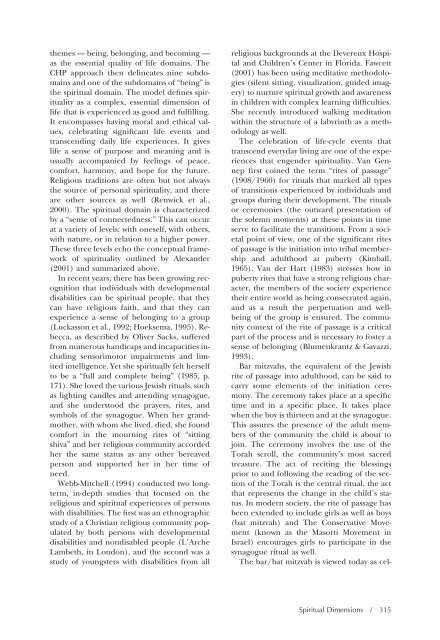Spiritual Dimensions of Bar/bat Mitzvah Ceremonies for Jewish ...
Spiritual Dimensions of Bar/bat Mitzvah Ceremonies for Jewish ...
Spiritual Dimensions of Bar/bat Mitzvah Ceremonies for Jewish ...
You also want an ePaper? Increase the reach of your titles
YUMPU automatically turns print PDFs into web optimized ePapers that Google loves.
themes — being, belonging, and becoming —<br />
as the essential quality <strong>of</strong> life domains. The<br />
CHP approach then delineates nine subdomains<br />
and one <strong>of</strong> the subdomains <strong>of</strong> “being” is<br />
the spiritual domain. The model defines spirituality<br />
as a complex, essential dimension <strong>of</strong><br />
life that is experienced as good and fulfilling.<br />
It encompasses having moral and ethical values,<br />
celebrating significant life events and<br />
transcending daily life experiences. It gives<br />
life a sense <strong>of</strong> purpose and meaning and is<br />
usually accompanied by feelings <strong>of</strong> peace,<br />
com<strong>for</strong>t, harmony, and hope <strong>for</strong> the future.<br />
Religious traditions are <strong>of</strong>ten but not always<br />
the source <strong>of</strong> personal spirituality, and there<br />
are other sources as well (Renwick et al.,<br />
2000). The spiritual domain is characterized<br />
by a “sense <strong>of</strong> connectedness.” This can occur<br />
at a variety <strong>of</strong> levels: with oneself, with others,<br />
with nature, or in relation to a higher power.<br />
These three levels echo the conceptual framework<br />
<strong>of</strong> spirituality outlined by Alexander<br />
(2001) and summarized above.<br />
In recent years, there has been growing recognition<br />
that individuals with developmental<br />
disabilities can be spiritual people, that they<br />
can have religious faith, and that they can<br />
experience a sense <strong>of</strong> belonging to a group<br />
(Luckasson et al., 1992; Hoeksema, 1995). Rebecca,<br />
as described by Oliver Sacks, suffered<br />
from numerous handicaps and incapacities including<br />
sensorimotor impairments and limited<br />
intelligence. Yet she spiritually felt herself<br />
to be a “full and complete being” (1985, p.<br />
171). She loved the various <strong>Jewish</strong> rituals, such<br />
as lighting candles and attending synagogue,<br />
and she understood the prayers, rites, and<br />
symbols <strong>of</strong> the synagogue. When her grandmother,<br />
with whom she lived, died, she found<br />
com<strong>for</strong>t in the mourning rites <strong>of</strong> “sitting<br />
shiva” and her religious community accorded<br />
her the same status as any other bereaved<br />
person and supported her in her time <strong>of</strong><br />
need.<br />
Webb-Mitchell (1994) conducted two longterm,<br />
in-depth studies that focused on the<br />
religious and spiritual experiences <strong>of</strong> persons<br />
with disabilities. The first was an ethnographic<br />
study <strong>of</strong> a Christian religious community populated<br />
by both persons with developmental<br />
disabilities and nondisabled people (L’Arche<br />
Lambeth, in London), and the second was a<br />
study <strong>of</strong> youngsters with disabilities from all<br />
religious backgrounds at the Devereux Hospital<br />
and Children’s Center in Florida. Fawcett<br />
(2001) has been using meditative methodologies<br />
(silent sitting, visualization, guided imagery)<br />
to nurture spiritual growth and awareness<br />
in children with complex learning difficulties.<br />
She recently introduced walking meditation<br />
within the structure <strong>of</strong> a labyrinth as a methodology<br />
as well.<br />
The celebration <strong>of</strong> life-cycle events that<br />
transcend everyday living are one <strong>of</strong> the experiences<br />
that engender spirituality. Van Gennep<br />
first coined the term “rites <strong>of</strong> passage”<br />
(1908/1960) <strong>for</strong> rituals that marked all types<br />
<strong>of</strong> transitions experienced by individuals and<br />
groups during their development. The rituals<br />
or ceremonies (the outward presentation <strong>of</strong><br />
the solemn moments) at these points in time<br />
serve to facilitate the transitions. From a societal<br />
point <strong>of</strong> view, one <strong>of</strong> the significant rites<br />
<strong>of</strong> passage is the initiation into tribal membership<br />
and adulthood at puberty (Kimball,<br />
1965). Van der Hart (1983) stresses how in<br />
puberty rites that have a strong religious character,<br />
the members <strong>of</strong> the society experience<br />
their entire world as being consecrated again,<br />
and as a result the perpetuation and wellbeing<br />
<strong>of</strong> the group is ensured. The community<br />
context <strong>of</strong> the rite <strong>of</strong> passage is a critical<br />
part <strong>of</strong> the process and is necessary to foster a<br />
sense <strong>of</strong> belonging (Blumenkrantz & Gavazzi,<br />
1993).<br />
<strong>Bar</strong> mitzvahs, the equivalent <strong>of</strong> the <strong>Jewish</strong><br />
rite <strong>of</strong> passage into adulthood, can be said to<br />
carry some elements <strong>of</strong> the initiation ceremony.<br />
The ceremony takes place at a specific<br />
time and in a specific place. It takes place<br />
when the boy is thirteen and at the synagogue.<br />
This assures the presence <strong>of</strong> the adult members<br />
<strong>of</strong> the community the child is about to<br />
join. The ceremony involves the use <strong>of</strong> the<br />
Torah scroll, the community’s most sacred<br />
treasure. The act <strong>of</strong> reciting the blessings<br />
prior to and following the reading <strong>of</strong> the section<br />
<strong>of</strong> the Torah is the central ritual, the act<br />
that represents the change in the child’s status.<br />
In modern society, the rite <strong>of</strong> passage has<br />
been extended to include girls as well as boys<br />
(<strong>bat</strong> mitzvah) and The Conservative Movement<br />
(known as the Masorti Movement in<br />
Israel) encourages girls to participate in the<br />
synagogue ritual as well.<br />
The bar/<strong>bat</strong> mitzvah is viewed today as cel-<br />
<strong>Spiritual</strong> <strong>Dimensions</strong> / 315

















